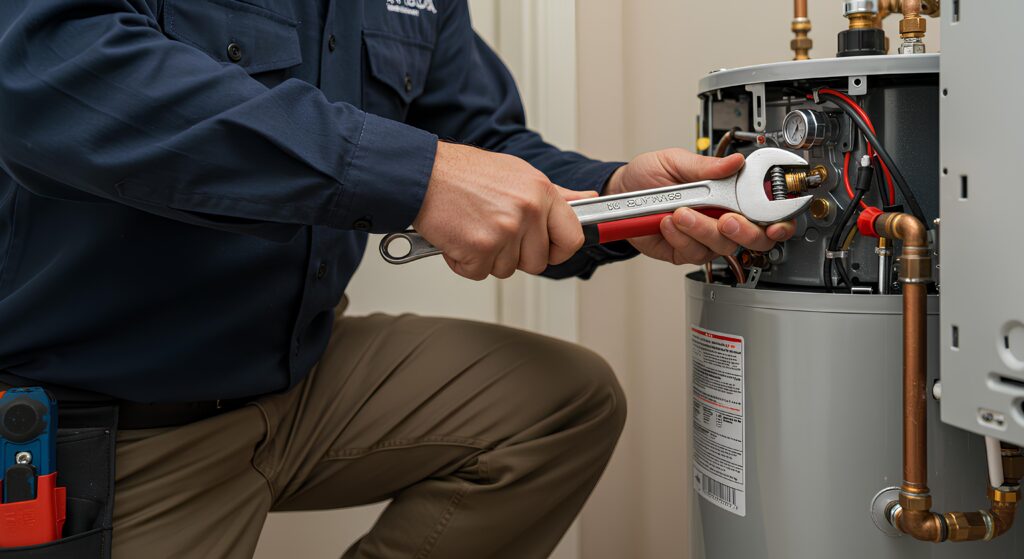With fall in full swing and colder weather just around the corner, now is the ideal time to give your home’s hot water system a check-up. A timely tune-up of your water heater can spare you cold showers, high energy bills, or even an unexpected breakdown when you’re counting on consistent hot water the most. Here’s how a pre-winter inspection pays off, especially here in Central Connecticut.
Why Now?
When temperatures drop, homeowners often use more hot water: for showers, laundry, dishwashing, and more. A water heater that’s neglected can struggle under the increased load or operate inefficiently due to hidden problems.
Common issues include:
- Sediment buildup inside tank-type water heaters reduces efficiency, forces the unit to run longer and harder, and can shorten its lifespan.
- Other issues such as a malfunctioning pressure relief valve or worn thermostat can leave you with no warning when cold weather hits.
Regular maintenance helps you avoid emergency repairs, so it pays to fix it now while it’s simple, rather than rush when you have no hot water. A tune-up now, which can help spot problems early on before they become expensive repairs, means more reliable, efficient service through the winter and better peace of mind.
What Should the Tune-Up Include?
Here’s a checklist of key items to inspect or service before winter. Some can be handled by homeowners, but many are best done by a licensed plumber, and that’s where bluefrog comes in.
Check the Temperature & Pressure (T&P) Relief Valve
This safety device prevents excessive pressure or temperature buildup in the tank. If it’s stuck, corroded or leaking, it could fail when you need it most.
-
- Open/close the valve briefly to verify flow (if safe/designed for home use) or have it professionally tested.
Flush Sediment from the Tank
Over time, minerals in the water settle at the bottom of a tank?type heater, forming sediment. That layer acts as an unintended insulator, making the heater work harder and less effectively.
-
- Flushing the tank removes the sediment, restoring capacity, improving efficiency and prolonging lifespan.
Inspect & Test the Thermostat or Heating Element
Especially in electric heaters (but also gas units), a thermostat or heating element that’s out of calibration can lead to inconsistent temperatures or excess energy use.
-
- Check that the thermostat is set to the manufacturer-recommended temperature (often ~120°F–140°F). Inspect for signs of wear or malfunction.
Examine Anode Rod (if applicable)
Many tank heaters have an anode rod whose job is to protect the tank from corrosion (think of it as a “sacrificial” metal rod; made of a softer metal like magnesium, aluminum, or an aluminum/zinc alloy, it corrodes instead of the tank itself). If the rod is heavily corroded or missing, the tank may start deteriorating.
-
- If your system is older, consider having the rod checked and replaced if needed.
Look for Leaks, Corrosion, & Pipe Connections
-
- Inspect around the tank base and connections for signs of rust, moisture, or drips.
- Check that venting (for gas units) is clear and properly secured.
- Verify expansion tanks or pressure relief plumbing (if installed) are functioning.
Test Hot-Water Output & Insulation
-
- Run the hot-water tap and assess if you get full temperature quickly.
- Ensure the tank and hot-water lines are insulated appropriately (this helps especially in colder basements).
- Confirm that any temperature/pressure sensors or smart controls are working if you have them.
How bluefrog’s Membership Makes It Easy
The good news? You don’t have to remember all of this yourself. Let the bluefrog Elite Membership cover your needs. By enrolling:
- You’ll have priority scheduling for routine tune-ups and inspections.
- Members get discounted rates on maintenance visits, so what might have been a worrying cost becomes a budgeted, predictable expense.
- Early detection means fewer emergencies, better system lifespan, and fewer costly repairs down the line.
Think of it as insurance for your hot-water comfort. Instead of waiting until a malfunction leaves you shivering, you’re proactively securing warm showers, efficient performance, and system longevity.
Quick DIY Checks You Can Do Now
While you wait for your scheduled professional visit (or if you’re a handy homeowner), here are a few fast checks you can do yourself:
- Feel the area around the base of your water heater for moisture or discoloration. If you spot it, flag it for review.
- Turn on a hot tap and listen for abnormal noises from the heater (popping, rumbling, or gurgling may indicate sediment buildup).
- Check thermostat settings and reduce to ~120°F if you typically don’t need extremely hot water (this saves energy and reduces stress on the tank).
- Ensure the area around the heater is clear of clutter and combustible materials and has adequate ventilation.
Don’t Let Maintenance Wait
Winter in Connecticut isn’t the time to gamble with your hot water system. A pre-winter tune-up of your water heater isn’t just about comfort; it’s about reliability, safety, savings and ensuring your home is prepared.
By tackling the key maintenance items now (the relief valve, sediment flush, thermostat check, system inspection) you avoid the risk of a breakdown or inefficient operation just when you need everything to work. And with bluefrog’s Elite Membership program, you’ve got a partner making that maintenance predictable, affordable and stress-free.
If you haven’t scheduled your tune-up yet, call bluefrog today. Let’s get your water heater ready for winter, so you can stay warm and worry-free, no matter how cold it gets outside. Just call us at (203) 937-2772 or visit bluefrogplumbingcentralct.com to schedule your pre-winter water heater tune-up and ask about membership benefits.
